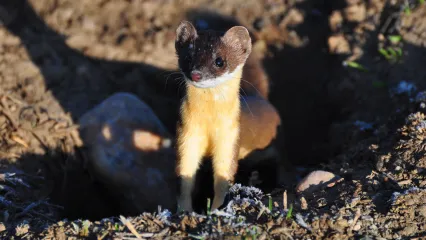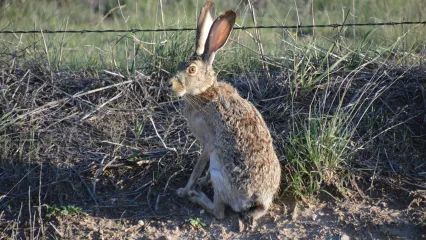
Description
The long-tailed weasel (Mustela frenata} is among nature's pest-control specialists. Its diet is made up primarily of small mammals such as mice, which helps control the number of farm pests.
With a higher metabolic rate than any other mammal of similar size, long-tailed weasels are valuable and effective hunters. They have a huge appetite and will eat as much as 40 percent of their body weight daily. Weasels are known to attack chicken coops and bird nests but are more likely to be a helpful presence by keeping rodents at bay.
Long-tailed weasels hunt by either smelling or hearing their prey and then following the animal to make a quick attack.
Oklahoma's weasels have a brown coat with a cream belly and a distinctive bushy black-ripped tail. They shed their fur twice a year. Oklahoma's weasels keep their brown fur throughout the year, but northern populations trade their brown coats for white coats for winter months.
Size
Long-tailed weasels have long, skinny bodies, short legs and a small head to more easily hunt burrowing animals such as shrews, gophers, mice and ground squirrels. Some larger weasels have even been known to hunt cottontail rabbits. Even though small mammals make up 95 percent of their diet, weasels will also eat birds, reptiles, fruits and berries.
Habitat
The long-tailed weasel makes its home in woodlands, farmlands, bottomlands and brushy areas across Oklahoma. Most commonly found in northeastern Oklahoma, weasels might be seen near their hiding places such as rock piles and firewood stacks.
Weasels have adapted well to environmental changes caused by people. They thrive in small wooded areas near suburbs and in crop fields. They build nests under rocks, in hollow logs, under barns and in the abandoned burrows of other animals.
They are solitary animals for most of the year. Their home range typically occupies 30 acres or more. The home ranges of male and female weasels may overlap, but those of the same sex do not. They are very territorial and arc aggressive toward intruders.
Life Cycle
Male and female weasels begin to cohabitate during the breeding season in summer. Mating typically occurs in July or August. Young weasels, called kits, are born in groups of four to eight in spring. Kits are born blind with wrinkled skin and white fur. The mother feeds the young for two months until they are able to kill prey on their own.
Females reach sexual maturity after only three months, and they begin breeding the summer after they are born. Males will begin mating a year later, taking 12 months to fully mature.
How To Observe
These predators are elusive, private and primarily nocturnal, which makes it difficult to track populations. But the species is stable throughout North America; Long-tailed weasels have a presence in most of North America, from extreme southern Canada throughout the United State and down to Central America. They can also be found in the northern portion of South America. Long-tailed weasel populations change locally in conjunction with the availability of prey.

